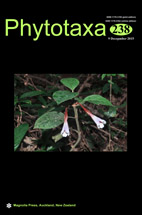Abstract
Vernonia monocephala subsp. irwinii is a member of the genus Lessingianthus and is hereby transferred to that genus with a new status and a new name, L. semirii. It differs from L. monocephalus by its subsessile to petiolate (vs. sessile) leaves, largely attenuate (vs. rounded to attenuate) leaf bases, adaxial leaf surfaces drying black (vs. greenish), tomentose to velutinous (vs. villous) abaxial leaf surface and stem indument, and number of florets per head (up to 120 vs. up to 210). Both species are native to provinces of the Cerrado Domain, but they do not occur sympatrically: L. semirii is restricted to the North-eastern floristic province (Bahia, Maranhão, Tocantins and Pará states) and northern portion of the Central-western floristic province (Mato Grosso state), whereas L. monocephalus occurs in Distrito Federal and Goiás states in the Central-western, Central and South-eastern floristic provinces. Lessingianthus semirii is hereby described and illustrated for the first time; a distribution map is provided and affinities of this species are discussed.

